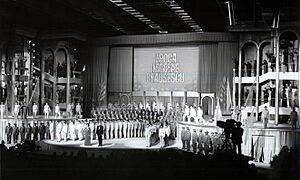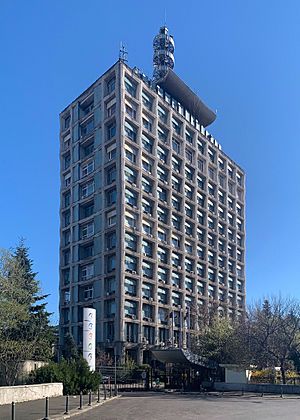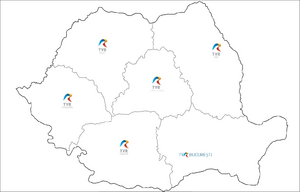TVR (TV network) facts for kids
 |
|
| Type | Broadcast television network |
|---|---|
| Country | Romania, Moldova through TVR Moldova |
| Motto | Imaginea timpului tău ("the image of your times") |
| Owner | Government of Romania |
| Key people | Dan Cristian Turturică, President and General Chairman |
| Launch date | 31 December 1956 |
| Former names | Radioteleviziunea Română (1956–1990; when it was the only radio-television company in the country) |
Televiziunea Română, better known as TVR, is the public television company of Romania. This means it is owned by the government and serves the people of the country. TVR runs nine different channels, including TVR 1, TVR 2, and TVRi for international viewers.
TVR also has six regional studios in major cities like Bucharest and Cluj-Napoca. These studios create shows about local news and events.
TVR 1 can be watched by almost everyone in Romania, reaching 99.8% of the population. While private TV networks often have more viewers, TVR offers a wide variety of programs and online streaming. Since November 2019, both TVR 1 and TVR 2 broadcast in high-definition (HD).
Contents
The History of TVR
How It All Began
TVR was founded in 1956 in Bucharest, the capital of Romania. Its very first broadcast was on New Year's Eve, December 31, from a small building that used to be a movie studio. This started a tradition of showing a special program every New Year's Eve to celebrate the past year and the anniversary of TV in Romania.
In 1969, TVR moved into a large, modern building designed just for television. This building is still the main headquarters for TVR today.
Television During the Ceaușescu Era
A second channel, TVR 2, was launched in 1968. The original channel then became known as TVR 1. However, in 1985, TVR 2 was taken off the air. This was part of an "energy saving program" by Romania's leader at the time, Nicolae Ceaușescu. For a few years, TVR 1 was the only channel in the country.
Limited Programming
From 1985 to 1989, TVR was only allowed to broadcast for about two hours each day. Most of the shows were about praising the country's leader, Nicolae Ceaușescu, and his wife, Elena. This is a form of propaganda, where media is used to make people think a certain way about political leaders.
The daily schedule was very strict. It usually started at 8:00 PM with the news, followed by programs about Ceaușescu, and then maybe a movie or a play. The broadcast would end at 10:00 PM. The American TV show Dallas was one of the only Western shows allowed to be aired.
The First Color Broadcasts
TVR first broadcast in color in 1983. While many countries in Eastern Europe used the French SECAM color system, Romania chose the German PAL system, which was used in Western Europe. Even though color TV was available, very few people had color TV sets, and most shows were still in black and white until after 1990.
TVR's Role in the 1989 Revolution
During the Romanian Revolution in December 1989, TVR played a very important role. On December 22, protesters took over the TVR building. They went on air to announce that the leader, Nicolae Ceaușescu, had left the country.
The station changed its name to "Televiziunea Română Liberă" (TVRL), which means "Free Romanian Television." After the revolution, the new government, led by the National Salvation Front (FSN), used TVRL to communicate with the public. However, some people felt the channel was being used for propaganda again, this time by the new leaders. After protests, the station changed its name back to TVR.
TVR After the Revolution
After 1990, TVR went through many changes. It struggled to find a new identity and rebranded itself several times. In 1993, TVR became a full member of the European Broadcasting Union (EBU), which is an organization of public broadcasters from across Europe.
In 1995, the international channel TVRi was launched for Romanians living in other countries. Over the years, TVR added more channels, like TVR Cultural in 2002, which focused on arts and culture.
Hosting Eurovision and Broadcasting Sports
In 2006, TVR hosted the Junior Eurovision Song Contest, a major international music competition for young singers. This was a big event for Romania.
TVR also started broadcasting major sports events. In 2008, it showed the UEFA Euro 2008 football tournament and the 2008 Summer Olympics in high-definition on its new channel, TVR HD.
Financial Troubles
In 2016, TVR faced a major problem. The EBU announced that Romania might not be able to participate in the Eurovision Song Contest because TVR owed the EBU a lot of money. The debt was over 16 million Swiss francs (about 14.5 million euros).
When TVR could not pay in time, the EBU removed it from the contest and other services. This was a difficult moment for the broadcaster. However, TVR made an agreement to pay back the debt and was able to return to Eurovision the next year.
TVR's Channels Today
TVR operates a family of channels, each with a different focus. It also has six regional channels that produce local shows.
| Name | Logo | Description | Date of launch |
|---|---|---|---|
| TVR 1 | The main channel with a mix of entertainment, news, and shows for everyone. | 31 December 1956 | |
| TVR 2 | A second general channel that also shows programs about arts and culture. | 2 May 1968 | |
| TVR 3 | Shows local programs made by TVR's six regional studios. | 10 October 2008 | |
| TVR Cultural | Focuses on programs about Romanian culture, history, and the arts. | 26 April 2002 | |
| TVR Folclor | A channel dedicated to Romanian folklore, music, and traditions. | 27 November 2023 | |
| TVR Info | TVR's news channel, showing news and documentaries. | 31 December 2008 | |
| TVR Internațional | A channel for Romanians living outside of Romania. | 1 December 1995 | |
| TVR Moldova | A special channel for the country of Moldova. | 1 December 2013 | |
| TVR Sport | A channel for sports like football, gymnastics, tennis, and more. | 30 March 2024 |
How Is TVR Funded?
Until 2017, TVR was paid for by a special fee called a television licence. Everyone who owned a TV had to pay this fee. The channel also made money from selling advertisements.
Today, the television licence fee has been removed. TVR is now funded mainly by the Romanian government, but it still earns some money from advertising.
See also
 In Spanish: Sociedad Rumana de Televisión para niños
In Spanish: Sociedad Rumana de Televisión para niños





